Grubs in lawns
Learn about the life history, damage caused by and description of various grubs commonly found in lawns.
Introduction
Grubs, the term given to larvae of scarab beetles, are frequently found feeding on the roots of turf and pasture grasses. Damage caused by white grubs initially resembles drought stress. As grub feeding continues, areas of turf (sod) begin to wilt and turn brown. In areas where their numbers exceed five to 10 per one-tenth of a square metre (1 sq. ft.), dead patches of turf will result. Turf that has been damaged by white grubs will lift away from the soil easily because the roots have been eaten and they no longer anchor the turf to the soil. Often, skunks and other small mammals will pull back the turf in search of a meal of grubs. This damage is usually more extensive than that caused by the grubs, but can be repaired by replacing the sod, tamping or rolling the surface and watering the area.
In parts of Ontario, there are three species of white grubs which infest lawns - European chafer, June beetle and Japanese beetle. The most common species is the European chafer, which has come from Europe and has invaded much of the southern portion of the province. It occurs along Lake Erie and has spread to areas north of London and Kitchener and east of Toronto. Another species, also imported, is the Japanese beetle and it has become established in some areas of the Niagara Peninsula and Hamilton-Wentworth region. Grubs of both species cause considerable damage to turfgrass, while the Japanese beetle adult is a serious pest of a large number of fruit and ornamental trees and shrubs. June beetles are native to North America, with approximately 152 species occurring in the United States and Canada. In Ontario there are three principal species
Description
Grubs of all species have soft, white, C-shaped bodies with tan or brown heads and six prominent, spiny legs (Figure 1). They are quite small when first hatched (3 to 4 mm long), but at maturity reach a length ranging from 2 cm (1 inch) for a Japanese beetle larvae to 4 cm for the June beetle grub. A healthy grub is milky white in colour, with the dark contents of its gut showing prominently through the cuticle at the hind end of the abdomen.
A distinguishing feature among these three species is the pattern of spines occurring on the underside of the tip of the abdomen (Figure 2). On either side of the midline, at the tip, a line of stout spines occurs. In the June beetle grub these two lines are parallel, converging at both ends (Figure 2a). In the European chafer grub, the lines of spines are parallel until the tip where they diverge (Figure 2b), while in the Japanese beetle larvae the spines form a V-shaped pattern (Figure 2c).
June beetle and European chafer adults are very similar in appearance (Figure 3). The European chafer is tan, while the June beetle is dark brown and larger. A distinguishing feature is the presence of a distinct tooth on each claw of the foot of the June beetle, while this tooth is considerably rounded or nearly absent in the European chafer (Figure 4). The Japanese beetle is striking in appearance with a metallic green head and thorax, bronze wing covers and six distinctive white tufts of hair along each side of its abdomen (Figure 5).

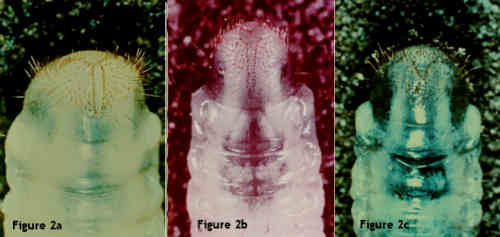
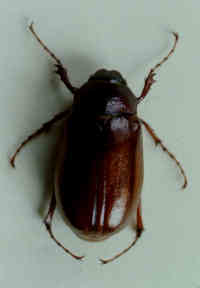
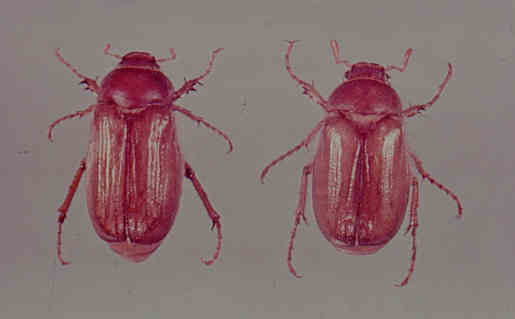

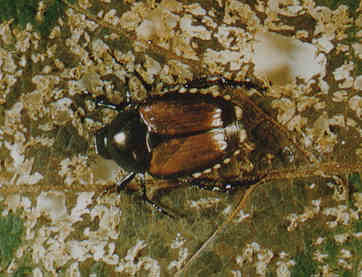
Damage
June beetle adults feed on the foliage of aspen, chestnut, elm, maple, oak, poplar and willow and may strip the leaves from shrubs, roses and raspberries. When numerous, they can cause considerable damage to trees and shrubs and, because they are attracted to lights, they can also become a nuisance around buildings. European chafer adults feed very little on foliage and are not a problem.
Adult Japanese beetles are a serious problem. More than 300 species of plants have been recorded as hosts for these beetles. They prefer apples, cherries, grapes, linden, maples, peaches and roses. In the Niagara Peninsula, this beetle poses a serious threat to the fruit and ornamental industries.
The grubs of all species feed on the roots of many plants, but prefer the fibrous roots of turfgrasses. As the root system is destroyed, sections of turf wilt, turn brown and can be easily pulled back to reveal grubs beneath (Figure 6). Secondary damage is also caused by skunks searching for grubs as food. Damage is most severe in the fall and the spring when the grubs are increasing in size rapidly and feeding near the surface.
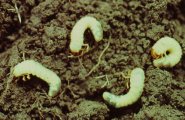
Life history
Each species of grub has a different life history with events or specific behaviour occurring during their life cycle that may be of use in control programs. For an overview of life cycles of the three species, see Figure 7.
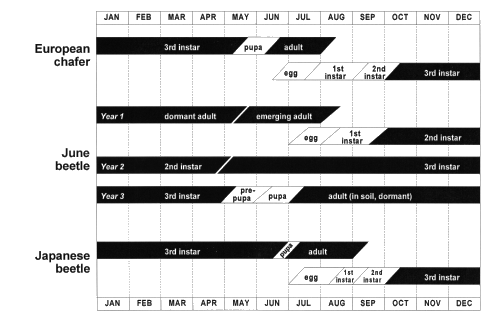
Accessible image description of Figure 7
June beetle
June beetles emerge from the soil during the latter part of May and early June and fly in large numbers. They take to the air at dusk and feed and mate on the foliage of broad-leaved trees and shrubs. At daylight they seek out grassy areas or weedy places and burrow into the soil where the females lay their eggs. The eggs hatch in a few weeks and for the remainder of the summer the young grubs feed on the roots of plants and decaying organic matter. In the fall, when the temperature drops, they go down deep in the soil and remain there during the winter. In the spring, when the soil warms, they return to the surface and feed ravenously on the roots during the spring and summer. This is the second-year of their three-year life cycle. Grubs cause the greatest damage during this period of their life cycle.
In the fall, they again go deep into the soil for the winter and again return to the surface the following spring. At that time, the grubs feed for only a few weeks before pupating and changing to beetles. The beetles, however, remain inactive in the soil until the next spring before taking flight. The life cycle is then complete and a new generation is started.
White grubs require three years to complete their life cycle and while it is possible to find all stages in any one year, the majority will follow a three-year pattern. In the past, outbreaks of white grubs have occurred every third year with the most severe damage caused by second-year grubs.
European chafer
European chafers emerge from turf in mid-June to mid-July, with variation across the province. At dusk, the adults congregate in large numbers to mate on trees which are isolated in large grassy areas or provide a silhouette effect near a large area of turf. Beetle activity occurs about the time hybrid-tea roses and catalpas are in full bloom. Very little feeding takes place, but the flights at dusk allow the beetles to mate. Females then return to the surrounding turfgrass areas and deposit their eggs in the soil below. The eggs require two weeks to hatch into small grubs, which feed near the surface. If moisture is not available, this process can be delayed by a couple of weeks. During periods of summer drought, grubs may remain deep in the soil where moisture is available. Once rainfall resumes, the grubs will migrate up to the soil/thatch interface to feed. By the end of September, most of the grubs are at their mature size and begin to seriously damage the turf. Cool weather does not seem to deter them, as they will remain near the surface if there is adequate moisture until frost begins to drive them down in November or December. They prefer to dig below the frost, but can withstand freezing if they cannot penetrate deeper.
In the spring they migrate to the surface when the frost leaves, even before the snow melts. Feeding at this time can cause damage with the grubs consuming the shallow roots and crowns. By mid- to late May they cease feeding and begin to transform into the resting pupal stage. They remain in this state until they emerge as adults in mid- to late June, completing a one-year life cycle. A flight of adults at dusk on warm evenings in June or early July may result in damage to surrounding turfgrass in the fall. Skunk damage to turf in the spring and fall as well as flocks of starlings or blackbirds feeding on turfgrass areas are signs of grub infestations.
Japanese beetle
Japanese beetles emerge in early July and may actively feed on a wide variety of trees and shrubs, including foliage, flowers and fruit for 30 to 45 days. After mating female beetles enter the soil under turf to a depth of 3 to 5 cm and deposit one to four eggs in one location. Females may lay as many as 60 eggs in their lifetime. Larvae hatch in two weeks and begin feeding on the roots in the upper 10 cm of soil. During drier periods, eggs may be killed and surviving larvae will be found deeper in the soil. In late summer and early fall, the grubs reach maturity and are generally found near the surface. As the soil temperature drops below 15°C. (60° F), the grubs migrate downward and will remain below the frost line during winter. When the soil temperature begins to warm above 15°C in the spring, the grubs will approach the surface again to feed.
Japanese beetle grubs are much more sensitive to soil temperature changes than European chafers and normally have migrated downward by mid- to late October and do not return to the surface until late April or May. Clues to infestations are the presence of adults on shrubbery, flowers, or fruit and damage to turf by skunks or other small mammals in the spring and fall. Traps containing a combination of both female attractants (pheromones) and a floral lure may be used to capture male beetles. Both attractants must be used together and traps should be placed every 2000 m2 (1 acre) from late June to mid-September. For more information on Japanese beetles, consult OMAFRA fact sheet Japanese beetle in nursery and turf.
Cultural control of grubs
Summer and fall weather conditions can have an effect on turf health and vigour which indirectly affects grub damage. Low rainfall during July and August can cause egg mortality because the eggs need to absorb moisture from the soil to hatch into grubs. In general, when there is sufficient rainfall or when turf is irrigated regularly, grub damage is reduced. Healthy, actively growing turf will have more roots and, hence, can withstand more grub feeding without turf loss. Conversely, lawns which are not vigorous and healthy will show turf damage quickly after small amounts of grub feeding. Maintaining a healthy lawn is your first line of defense against grubs.
Repairing grub damage
If a lawn is damaged by grub feeding or by skunks, raccoons or starlings feeding on grubs the lawn can be re-seeded or sodded. The best time do do this is in spring after the majority of the grub damage is done.
Rake damaged area to remove dead sod. Uniformly broadcast a good quality lawn seed . Ensure that the seed is in contact with the soil by raking it in. Spread topsoil or compost over the seeded area. A light rolling will help firm the seed bed and insure the seeds are in contact with the soil. The seedbed should be kept moist until the seeds have germinated and the seedlings are well established. This may require a light sprinkling several times a day. Once the seedlings are established, routine mowing and lawn maintenance can resume.
For immediate results, spot sodding can also be done to repair grub damaged lawns. Prepare the soil as for seeding but allow for the thickness of the sod to be at the same level as the existing lawn. Maintain good moisture until the sod is well rooted. Re-sodding can be done throughout the season providing irrigation is available.
References
- Turfgrass Management Recommendations. OMAFRA Publication 384.
Pam Charbonneau is a Turfgrass Specialist, Agriculture and Rural Division, OMAFRA. M.K. Sears is with the Department of Environmental Biology, University of Guelph.
Accessible image description
Figure 7. Summary of European chafer, June beetle and Japanese beetle life cycle
An overview of the life cycle of the: European chafer, June beetle and the Japanese beetle.
European chafer
- 3rd instar - January to mid May
- Pupa - mid May to mid June
- Adult - mid June to mid August
- Egg - mid June to August
- 1st instar - mid July to mid September
- 2nd instar - September to mid October
- 3rd instar - October to December
June beetle
Year 1:
- Dormant adult - January to mid May
- Emerging adult - mid May to mid August
- Egg - July to mid August
- 1st instar - August to October
- 2nd instar - mid September to December
2nd Year:
- 2nd instar - January to mid May
- 3rd instar - mid May to December
3rd Year:
- 3rd instar - January to mid May
- Pre-pupa -End of April to mid June
- Pupa - June to mid July
- Adult (in soil, dormant) - July to December
Japanese beetle
- 3rd instar - January to July
- Pupa - mid June to mid July
- Adult - July to mid September
- Egg - July to mid August
- 1st instar - mid August to mid September
- 2nd instar - September to mid October
- 3rd instar - October to December